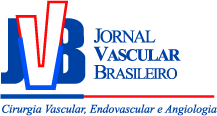Estudo comparativo entre os achados do exame físico, do mapeamento com eco-color Doppler e da exploração cirúrgica na recidiva das varizes de membros inferiores a partir da junção safeno-femoral
Comparative study among the physical examination, echo-color Doppler mapping and operative approaching in the recurrent lower extremity varicose veins from the saphenofemoral junction
Gilberto Narchi Rabahie; Daniel Reis Waisberg; Lourdes Conceição Martins; Mariane Martins Manso; Newton Eiji Kitamura; Jaques Waisberg
Resumo
Palavras-chave
Abstract
References
Darke SG. The morphology of recurrent varicose veins. Eur J Vasc Surg.. 1992;6(5):512-7.
Sarin S, Scurr JH, Coleridge Smith PD. Assessment of stripping the long saphenous vein in the treatment of primary varicose veins. Br J Surg.. 1992;79(9):889-93.
Bradbury AW, Stonebridge PA, Ruckley CV. Recurrent varicose veins: correlation between preoperative clinical and hand-held Doppler ultrasonographic examination, and anatomical findings at surgery. Br J Surg.. 1993;80(7):849-51.
Perrin MR, Guex JJ, Ruckley CV. Recurrent varices after surgery (REVAS), a consensus document. REVAS group. Cardiovasc Surg.. 2000;8(4):233-45.
De Maeseneer MG, Van Schil PE, Philippe MM. Is recurrence of varicose veins after surgery unavoidable?. Acta Chir Belg.. 1995;95(1):21-6.
Luccas GC, Menezes FH, Barel EV. Varizes dos membros inferiores - tratamento. Cirurgia Vascular. 2002:1034-51.
Franco G, Nguyen KAC G, Lefebvre-Villardebo M. Apport de l´echo doppler couleue dans les récidives variqueuses post-opèratoires au niveau de la region inguinale. Phlebologie. 1995;48(2):241-50.
Rivlin S. The surgical cure of primary varicose veins. Br J Surg.. 1975;62(11):913-7.
Negus D. Recurrent varicose veins: a national problem. Br J Surg.. 1993;80(7):823-4.
Geier B, Stücker M, Hummel T. Residual stumps associated with inguinal varicose vein recurrences: a multicenter study. Eur J Vasc Endovasc Surg.. 2008;36(2):207-10.
Heim D, Negri M, Schlegel U. Resecting the great saphenous stump with endothelial inversion decreases neither neovascularization nor thigh varicosity recurrence. J Vasc Surg.. 2008;47(5):1028-32.
Donati M, Gandolfo L, Brancato G. Recurrent varicose veins due to neovascularisation: can they be prevented?. Chir Ital.. 2008;60(1):83-90.
van Rij AM, Jones GT, Hill BG. Mechanical inhibition of angiogenesis at the saphenofemoral junction in the surgical treatment of varicose veins: early results of a blinded randomized controlled trial. Circulation. 2008;118(1):66-74.
Moreau PM. Neovascularization is not a major cause of varicose veins recurrence. Int J Angiol. 2002;11(2):99-101.
Bartos Junior J, Bartos J. Causes of recurrencies following procedures for varicose veins of the lower extremities. Rozhl Chir.. 2006;85(6):293-5.
Tong Y, Royle J. Recurrent varicose veins following high ligation of long saphenous vein: a duplex ultrasound study. Cardiovasc Surg.. 1995;3(5):485-7.
Benabou JE, Molnar LJ, Cerri GG. Duplex sonographic evaluation of the sapheno-femoral venous junction in patients with recurrent varicose veins after surgical treatment. J Clin Ultrasound.. 1998;26(8):401-4.
Berni A, Tromba L, Mosti G. La comparsa di varici dopo loro trattamento: Studio multicentrico del Doppler Club Italiano Societá di Clinica e Tecnologia. Minerva Cardioangiol. 1998;46(4):87-90.
Wali MA, Sheehan SJ, Colgan MP. Recurrent varicose veins. East Afr Med J.. 1998;75(3):188-91.
Jiang P, van Rij AM, Christie R. Recurrent varicose veins: patterns of reflux and clinical severity. Cardiovas Surg.. 1999;7(3):332-9.
Roscitano G, Mirenda F, Mandolfino T. Varicose vein recurrence after surgery of the sapheno-femoral junction: color Doppler ultrasonography study. Chir Ital.. 2003;55(6):893-6.
Cerri GG, Molnar LJ, Vezozzo DC. Doppler: Avaliacao duplex do sistema venoso profundo e superficial. 1996:69-89.
Zwiebel W. Introdução à ultrassonagrafia vascular: exame venoso periféricoMódulo IV. 1998:244-349.
Eklöf B, Rutherford RB, Bergan JJ. Revision of the CEAP classification for chronic venous disorders: consensus statement. J Vasc Surg.. 2004;40(6):1248-52.
Li AK. A technique for re-exploration of the saphenofemoral junction for recurrent varicose veins. Br J Surg.. 1975;62(9):745-6.
Stalker LK, Heyerdale W. Factors in recurrence of varices following treatment. Surg Gynecol Obstet.. 1940;71:723-30.
Glasser ST. An anatomic study of venous variations of the fossa ovalis: The significance of recurrences following ligations. Arch Surg.. 1943;46:289-95.
Luke JC. The management of recurrent varicose veins. Surgery. 1954;35(1):40-4.
Lofgren KA, Ribisi AP, Miyers TT. An evaluation of stripping versus ligation for varicose veins. AMA Arch Surg.. 1958;76(2):310-6.
Morais Filho D, El Hozni Junior RA, Diniz JAM. Uso do duplex ultra-som no planejamento do tratamento cirúrgico de varizes dos membros inferiores. Cir Vasc Angiol.. 1999;15(2):43-9.
Perrin M, Gobin JP, Nicolini P. Les recidives au pli de l'aine après chirurgie des varices. J Mal Vasc.. 1997;22(5):303-12.
Enrici EA, Regalado OE, Enrici A. Várices recidivadas luego de la cirugía venosa de los miembros inferiores. Rev Argent Cir.. 2001;81(3/4):107-16.
França GJ, Timi JR, Vidal EA. O eco-Doppler colorido na avaliação das varizes recidivadas. J Vasc Bras.. 2005;4(2):161-6.
Rodríguez O, Valenzuela R S, Mebold P J. Recurrencia de várices en el Hospital Barros Luco-Trudeau. Rev Chil Cir.. 2004;56(5):470-4.
Labropoulos N, Touloupakis E, Giannoukas AD. Recurrent varicose veins: investigation of the pattern and extent of reflux with color flow Duplex scanning. Surgery.. 1996;119(4):406-9.
van Rij AM, Hill G, Gray C. A prospective study of the fate of venous leg perforators after varicose vein surgery. J Vasc Surg.. 2005;42(6):1156-62.
Egan B, Donnelly M, Bresnihan M. Neovascularization: an "innocent bystander" in recurrent varicose veins. J Vasc Surg.. 2006;44(6):1279-84.
Zaraca F, Ebner H. Causes and treatment of recurrent varices of the lower limbs. Chir Ital.. 2005;57(6):761-5.
Hayden A, Holdsworth J. Complications following re-exploration of the groin for recurrent varicose veins. Ann R Coll Surg Engl.. 2001;83(4):272-3.
De Maeseneer MG, Philipsen TE, Vanderbroeck CP. Closure of the cribriform fascia: an efficient anatomical barrier against postoperative neovascularization at the saphenofemoral junction? A prospective study. Eur J Vasc Endovasc Surg.. 2007;34(3):361-6.



